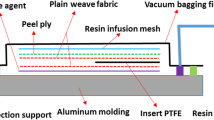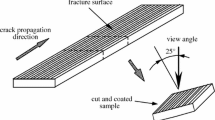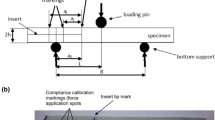Abstract
The fracture behaviour of two toughened epoxy composite systems was investigated using various microscopy techniques. The Mode I delamination fracture toughness,G IC, Mode II delamination fracture toughness;G IIC, and compression after impact (CAI) strength of these model composite systems were also measured. Under Mode I fracture, it was found that these composites exhibit nearly identical toughening mechanisms to those of the rubber-modified neat resins. The composites differ primarily in having smaller damage zones than the neat resin equivalents. Under Mode II fracture, the typical hackles were found to initiate from inside the resin-rich interlaminar region due to the presence of the toughener particles. The CAI strength, based on the present study as well as the work conducted by others, appeared to be related to, but not necessarily strongly dependent on, the interlaminarG IC andG IIC, the thickness of the interlaminar resin-rich region, and the type of the interlaminar toughener particles. Approaches for improving theG IC,G IIC, and CAI strength of high-performance toughened composites are discussed.
Similar content being viewed by others
References
N. ODAGIRI and H. KISHI,Polym. Preprint 33 (1992) 384.
D. S. PARKER and A. F. YEE,J. Therm. Compos. Mater. 2 (January) (1989) 2.
W. L. BRADLEY, in “Application of Fracture Mechanics to Composite Materials”, edited by K. Friedrich (Elsevier Applied Science, New York, 1989) p. 159.
C. R. CORLETO and W. L. BRADLEY, in “Composite Materials: Fracture and Fatigue”, Vol. 2, ASTM STP 1012, edited by P. A. Lagace (American Society for Testing and Materials, Philadelphia, PA, 1989) p. 201.
C. B. BUCKNALL, in “Advanced Composites”, edited by I. K. Partridge, (Elsevier Applied Science, New York, 1989) p. 145.
D. L. CRANE, MS thesis, Texas A and M University (1990).
W. L. BRADLEY, in “Proceedings of the Benibana International Symposium”, October 1990.
D. HUNSTON and R. DEHL, “The Role of Matrix Toughness in Matrix Dominated Composite Fracture” (Society of Manufacturing Engineers, 1987) p. 355.
W. L. BRADLEY, in “The Role of Matrix Properties on the Toughness of Thermoplastic Composite”, edited by R. B. Pipe (Elsevier Applied Science, New York, 1991) p. 295.
J. E. MASTERS, in “Proceedings of 6th International Conference on Composite Materials”, Vol. 3 (Elsevier Applied Science, New York, 1987) p. 396.
I. GAWIN, US Pat. 4 783 506 (1988).
R. E. EVANS, and K. R. HIRSCHBUEHLER, US Pat. 4 604 319(1986).
N. ODAGIRI, H. KISHI and T. NAKAE, “T800H/3900-2 Toughened Epoxy Prepreg System: Toughening Concept and Mechanism” (6th American Society for Composites, New York, 1991) p. 43.
M. A. HOISINGTON and J. C. SEFERIS, “Process-Structure-Property Relationship for Layered Structured Composites” (6th American Society for Composites, New York, 1991) p. 53.
H.-J. SUE, R. A. PEARSON and A. F. YEE,Polym. Eng. Sci. 24 (1989) 1447.
H.-J. SUE, PhD thesis, The University of Michigan, Ann Arbor, MI (1988).
H.-J. SUE and A. F. YEE,J. Mater. Sci. 26 (1991) 3449.
K.-K. KOO, T. INOUE and K. MIYASAKA,Polym. Eng. Sci. 25 (1985) 741.
H.-J. SUE, E. I. GARCIA-MEITIN and P. C. YANG,Composites (1992) submitted.
A. F. YEE. in “Toughened Composites”, STP 937, edited by N. J. Johnston (American Society for Testing and Materials, Philadelphia, PA, 1986) p. 383.
R. E. JONES and D. L. CALDWELL, “The Correlation of Resin Toughness and the Fiber-Resin Interfacial Shear Strength with Damage Tolerance” (5th American Society for Composites, New York, 1990) p. 154.
D. E. HENTON, D. M. PICKELMAN, C. B. ARENDS and V. E. MEYER, US Pat. 4 778 851 (1988).
H.-J. SUE, E. I. GARCIA-MEITIN, D. M. PICKELMAN and P. C. YANG, in “Toughened Plastics: Science and Engineering”, ACS Vol. 233, edited by C. K. Riew, in press.
E. I. GRACIA-MEITIN and H.-J. SUE, in preparation.
K. FRIEDRICH (Ed.), “Application of Fracture Mechancis to Composite Materials” (Elsevier Science, New York, 1989).
S. HASHEMI, A. J. KINLOCH and J. G. WILLIAMS,Proc. R. Soc. A 427 (1990) 173.
J. G. WILLIAMS,J. Strain Anal. 24 (1989) 207.
S. HASHEMI, A. J. KINLOCH and J. G. WILLIAMS, in “Composite Materials: Fatigue and Fracture”, Vol. 2, ASTM STP 1110, edited by T. K. O'Brien (American Society for Testing and Materials, Philadelphia, PA, 1991) p. 143.
SACMA Standard SRM 2-88.
P. C. YANG, E. P. WOO, S. A. LAMAN, J. J. JAKUBOWSKI, D. M. PICKELMAN and H.-J. SUE, in “36th International SAMPE Conference”, Vol. 36 (1991) p. 437.
A. J. LESSER and A. G. FILIPPOV,ibid.in “ (1991) p. 886.
H.-J. SUE,Polym. Eng. Sci. 31 (1991) 275.
A. J. KINLOCH, “Adhesion and Adhesives” (Chapman and Hall, New York, 1987).
W. D. BASCOM and S. Y. GWEON, in “Fractography and Failure Mechanisms in Polymers and composite”, edited by A. C. Roulin-Moloney (Elsevier Applied Science, New York. 1989).
T. JOHANNESSON, P. SJOBLOM and R. SELDEN,J. Mater. Sci. 19 (1984) 1171.
G. E. MORRIS, in “Nondestructive Evaluation and Flaw Critically for Composite Materials”, edited by R. B. Pipe, ASTM STP 696 (American Society for Testing and Materials, Philadelphia, PA, 1979) p. 274.
B. W. SMITH and R. A. GROVE, in “Fractography of Modern Engineering Materials”, edited by J. E. Masters and J. J. Au, ASTM STP 948 (American Society for Testing and Materials, Philadelphia, PA, 1987) p. 154.
M. CHARALAMBIDES, A. J. KINLOCH, Y. WANG and J. G. WILLIAMS,Int. J. Fract. (1992) in press.
P. B. BOWDEN, in “The Physics of Glassy Polymers” edited by R. Haward (Applied Science, London, 1973).
M. F. HIBBS and W. L. BRADLEY, in “Fractography of Modern Engineering Materials”, edited by J. E. Masters and J. J. Au, ASTM STP 948 (American Society for Testing and Materials, Philadelphia, PA, 1987) p. 68.
Author information
Authors and Affiliations
Rights and permissions
About this article
Cite this article
Sue, H.J., Jones, R.E. & Garcia-Meitin, E.I. Fracture behaviour of model toughened composites under Mode I and Mode II delaminations. J Mater Sci 28, 6381–6391 (1993). https://doi.org/10.1007/BF01352201
Accepted:
Issue Date:
DOI: https://doi.org/10.1007/BF01352201




